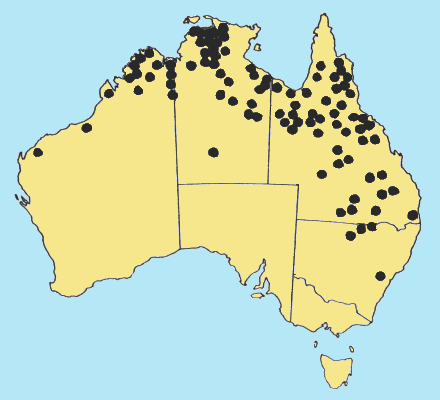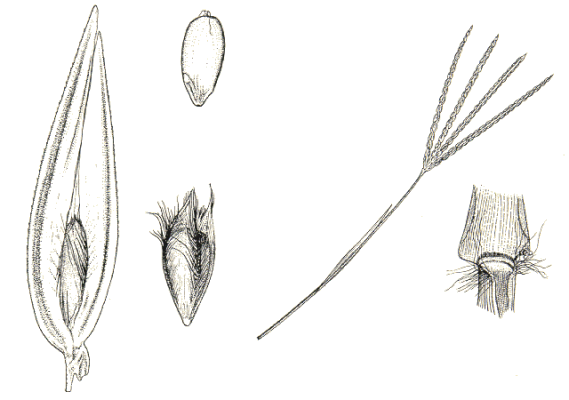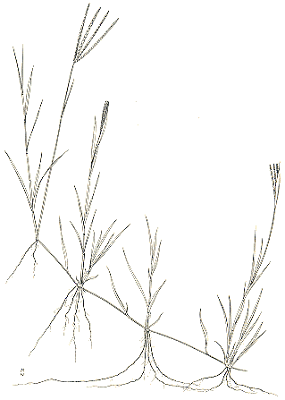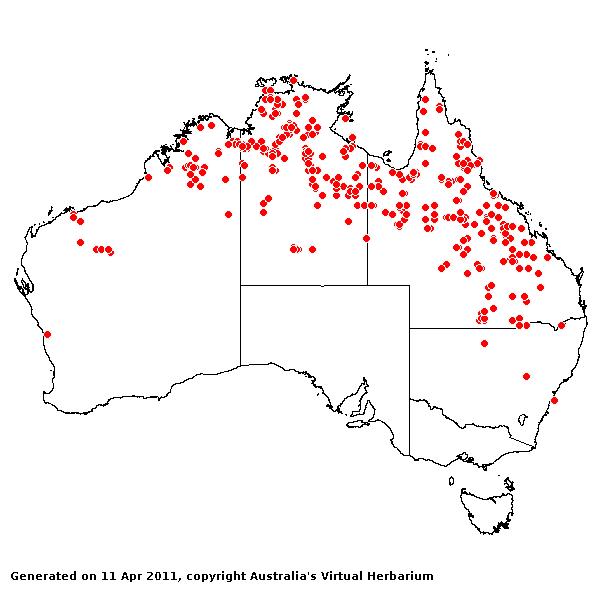Brachyachne convergens (F.Muell.) Stapf. Hooker's
Ic. Pl. t. 3099: (1922).
Classification. (GPWG 2001) : Subfamily
Chloridoideae. Cynodonteae.
Basionym and/or
Replacement Name: Cynodon
convergens F. Muell., Fragmenta Phytographiae Australiae 8: 113
(1873).
Type of Basionym or
Protologue Information: Victoria R., N.T., Elsey; holo: MEL; iso: K.
Key references
(books and floras): [1878] G.Bentham, Flora Australiensis 7 (610as Cynodon
convergens), [1952] C.A.Gardner, Flora of Western Australia 1 Gramineae
(214), [1981] M.Lazarides in J.Jessop (ed)., Flora of Central Australia
(466), [2002] D.Sharp & B.K.Simon, AusGrass, Grasses of Australia,
[2008] S.W.L.Jacobs, R.D.B.Walley & D.J.B.Wheeler, Grasses of New South
Wales (170).
Illustrations:
[1952] C.A.Gardner, Flora of Western Australia 1 Gramineae (213,
Pl. 63), [2005] K.Mallet (ed.), Flora of Australia 44B: Poaceae 3
(Fig. 50A-E, Fig. 51A), [2008] S.W.L.Jacobs, R.D.B.Whalley & D.J.B.Wheeler,
Grasses of New South Wales, 4th edn (170).
Habit. Annual
or perennial. Stolons absent or present. Culms erect or geniculately ascending
or decumbent, 20–60 cm tall. Ligule a fringed membrane, 0.5 mm long.
Leaf-blades 3–6 cm long, 2–3 mm wide. Leaf-blade surface glabrous or
indumented.
Inflorescence.
Inflorescence digitate, with spicate branches.
Spikelets.
Spikelets sessile. Fertile spikelets 1-flowered, comprising 1 fertile
floret(s), without rachilla extension, lanceolate or oblong, laterally
compressed, 3–5 mm long.
Glumes. Glumes
similar, firmer than fertile lemma. Lower glume oblong, coriaceous, keeled,
1-keeled, winged on keel, winged broadly, 1 -nerved. Upper glume oblong, 3–5 mm
long, coriaceous, keeled, 1-keeled, winged on keel, 1 -nerved.
Florets.
Fertile lemma 2.2–2.8 mm long, keeled, 3 -nerved. Lemma apex muticous or
mucronate. Palea 2 -nerved. Grain 1.7–2 mm long.
Continental
Distribution: Australasia.
Australian
Distribution: Western Australia, Northern Territory, Queensland, New South
Wales.
Western Australia:
Gardner, Fitzgerald, Hall, Dampier. Fortescue. Northern Territory:
Darwin & Gulf, Victoria River, Barkly Tableland, Central Australia North. Queensland:
Burke, Cook, Darling Downs, Gregory North, Leichhardt, Maranoa, Mitchell, North
Kennedy, South Kennedy, Warrego, Port Curtis. New South Wales: Central
Coast, North-Western Plains.
Notes.
Considered good dry season fodder in northern Australia.
The strongly flattened grain and contiguous
keels of the palea distinguish it from other species in Australia. From B.
tenella and B. ambigua, B. convergens differs further by its
greater spikelet dimensions, usually bearded sheath auricles, and coarser
usually stoloniferous habit. The spikes resemble those of B. ciliaris
which, however, can be recognized by its villous foliage, inflorescence of
usually two spikes, and the subapical fringe on the lemma and palea.
Endemic;
occurs in summer rainfall area across the continent N of the Tropic of
Capricorn, excluding desert areas of the N.T. and W.A., and S central Qld, with
a few records from northern N.S.W. and the central E coast; Recorded from a range
of habitats including claypans, river banks, levees and floodplains, irrigated
cotton fields, gorges and sandplains, often in disturbed areas such as
roadsides; in red, brown grey or black soils of light to heavy texture;
colonizes bare patches and also found in association with Astrebla or
other grasses, and in dense to open woodland, brigalow, pindan or monsoon vine
thicket; usually common or dominant in the understorey where it occurs.









